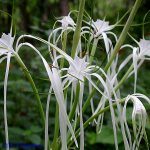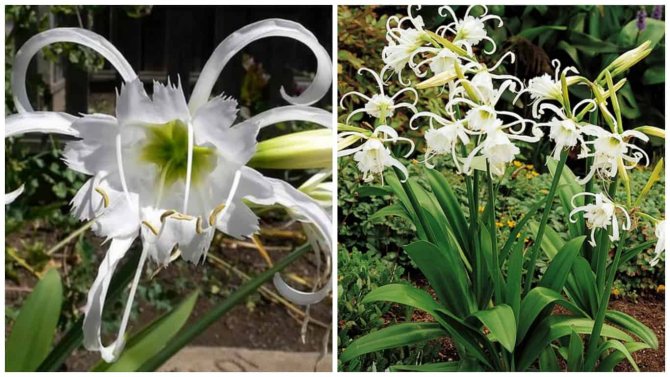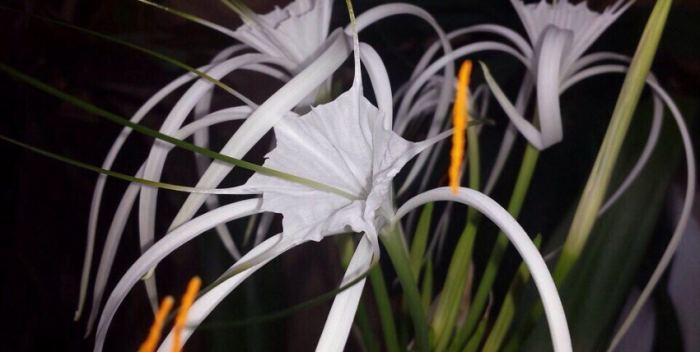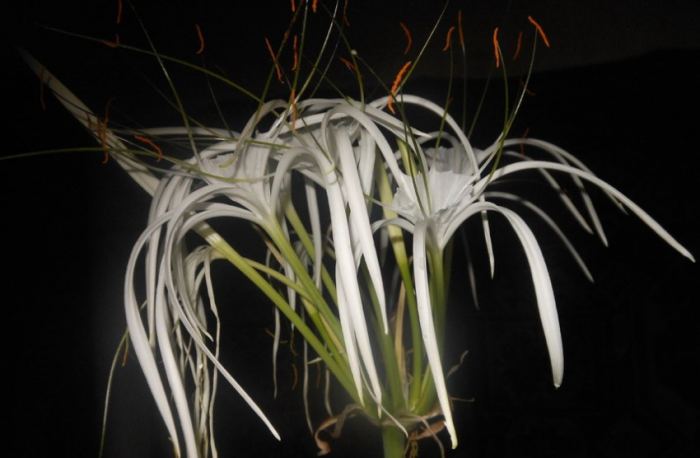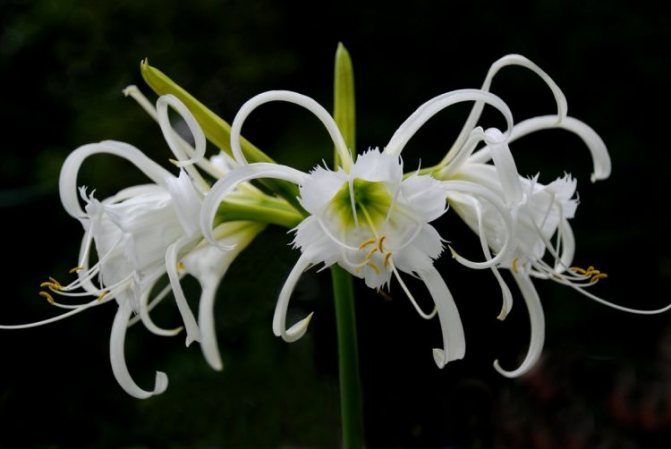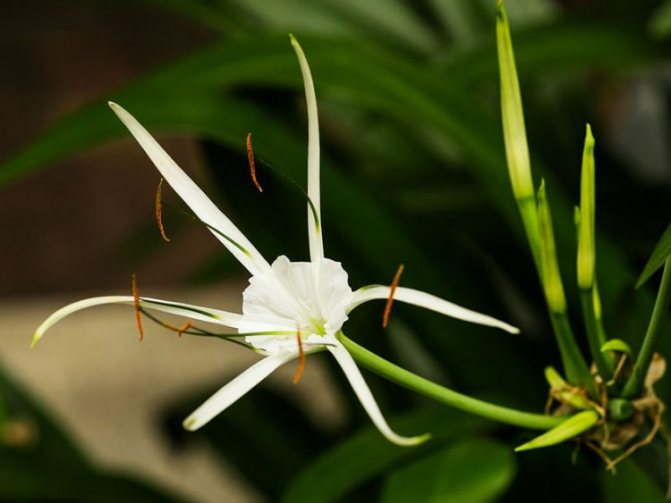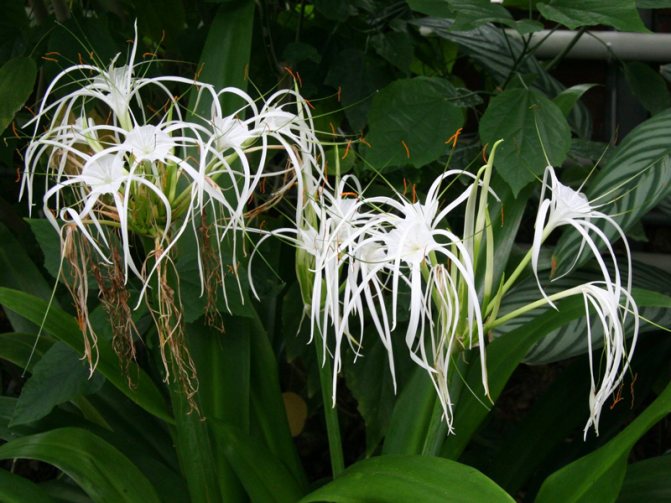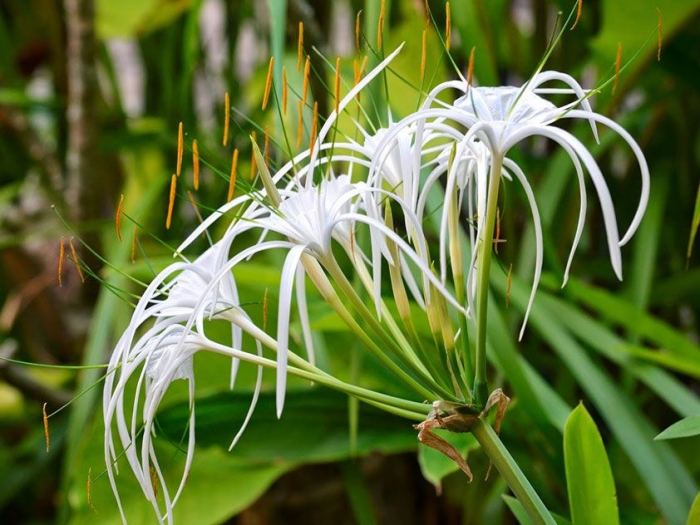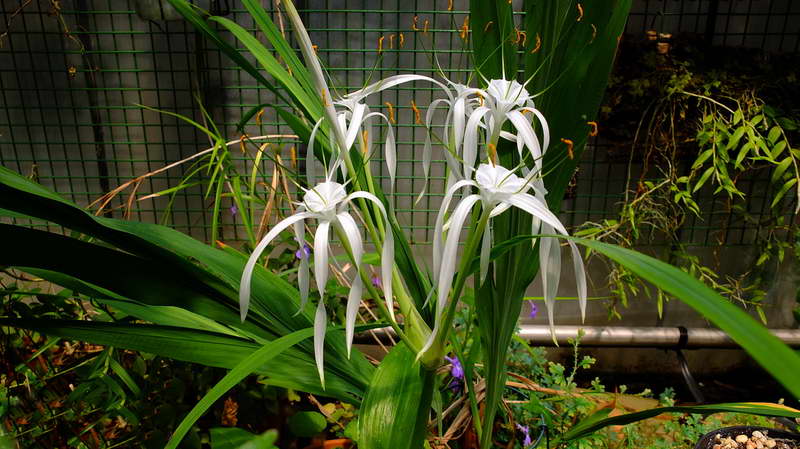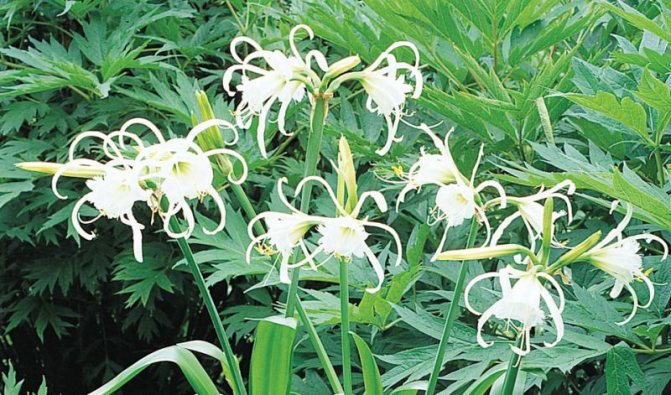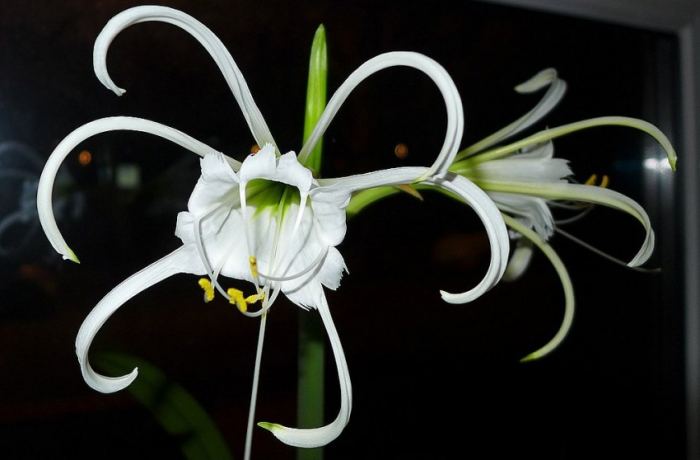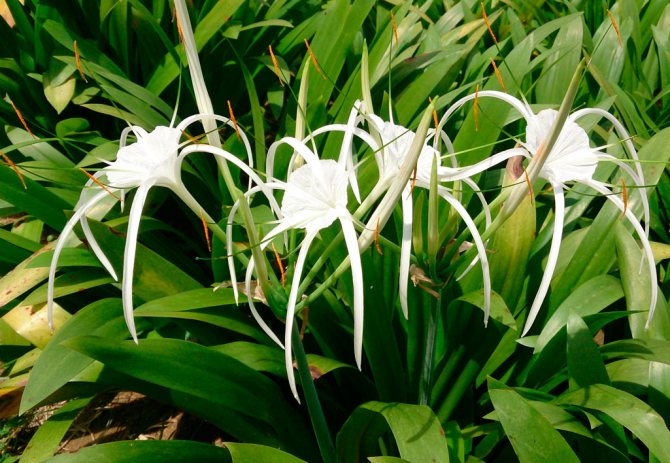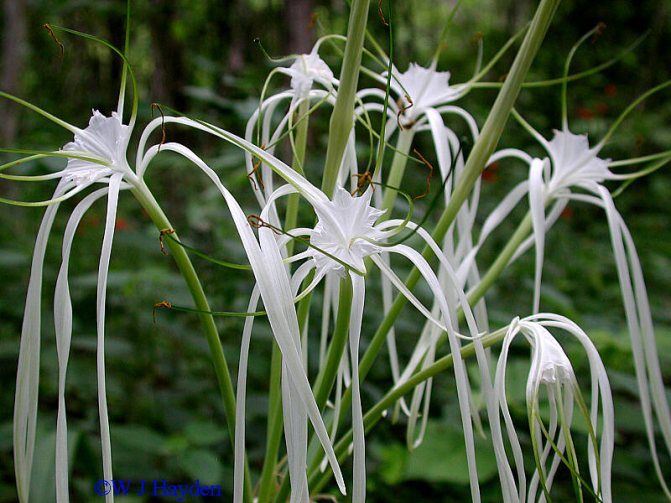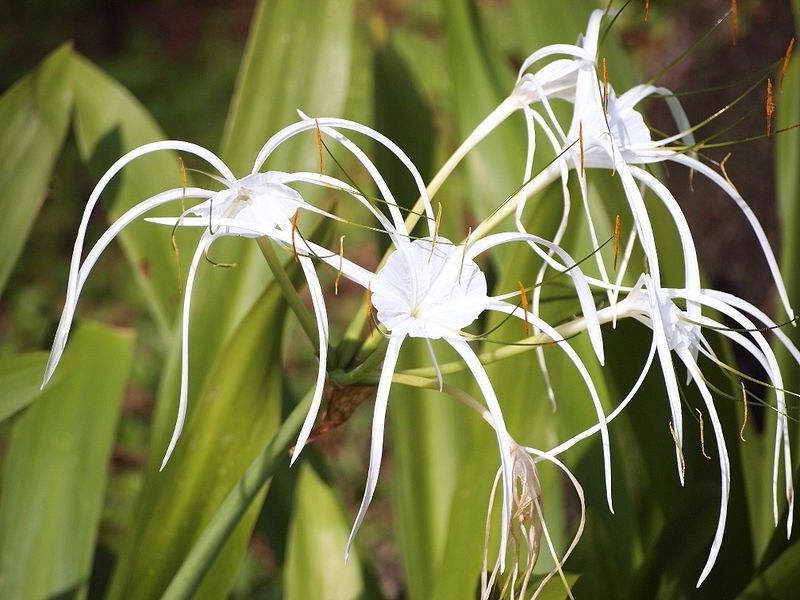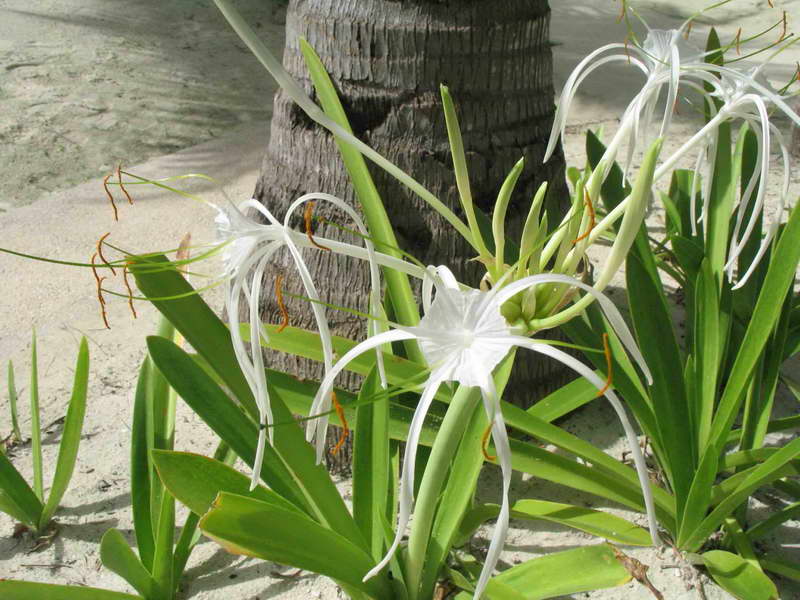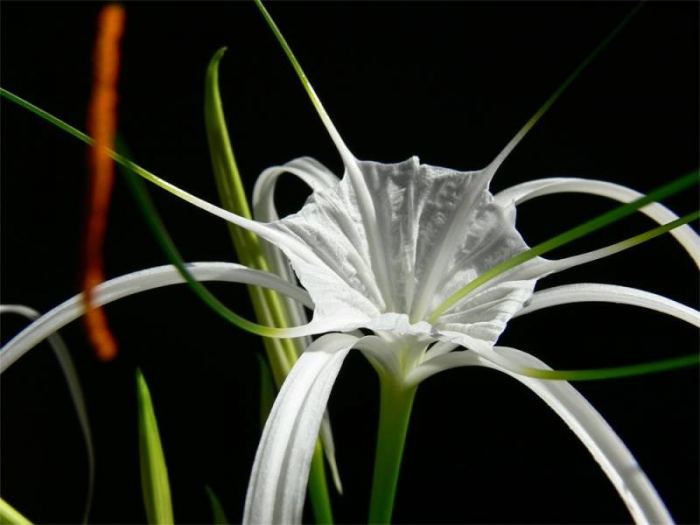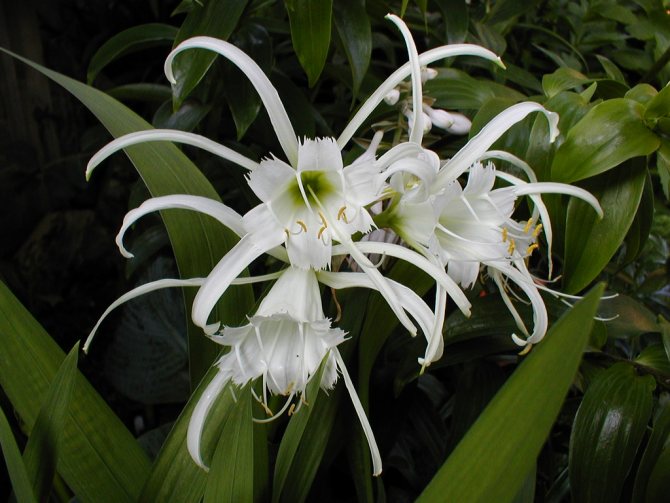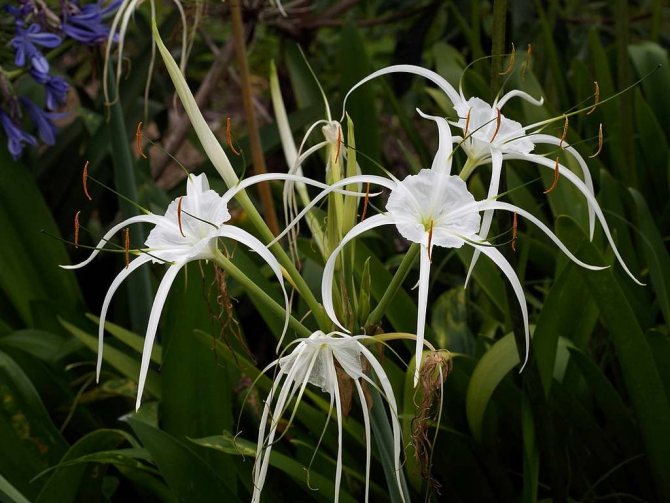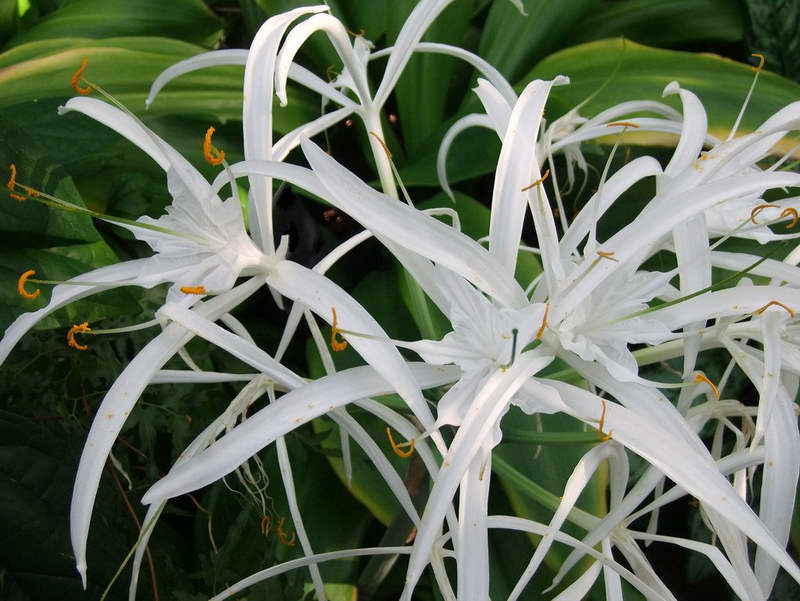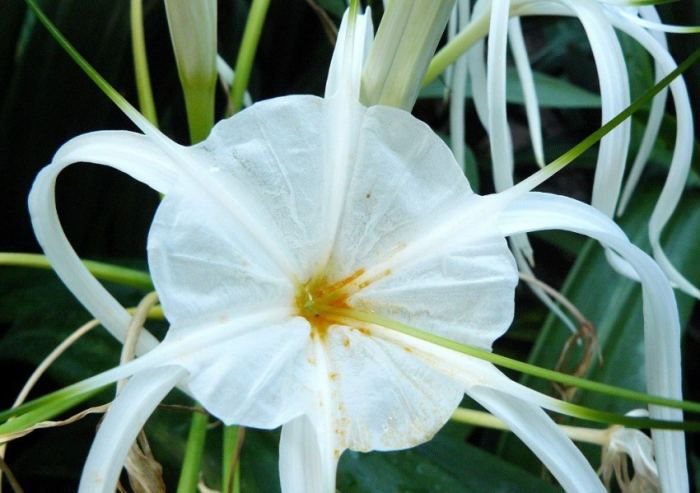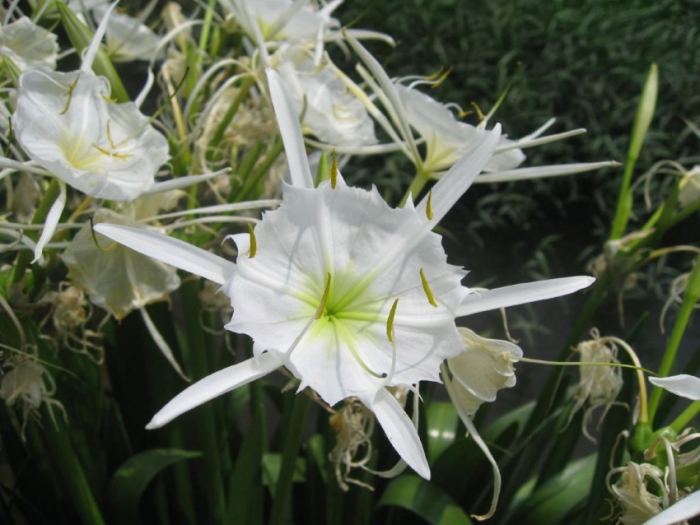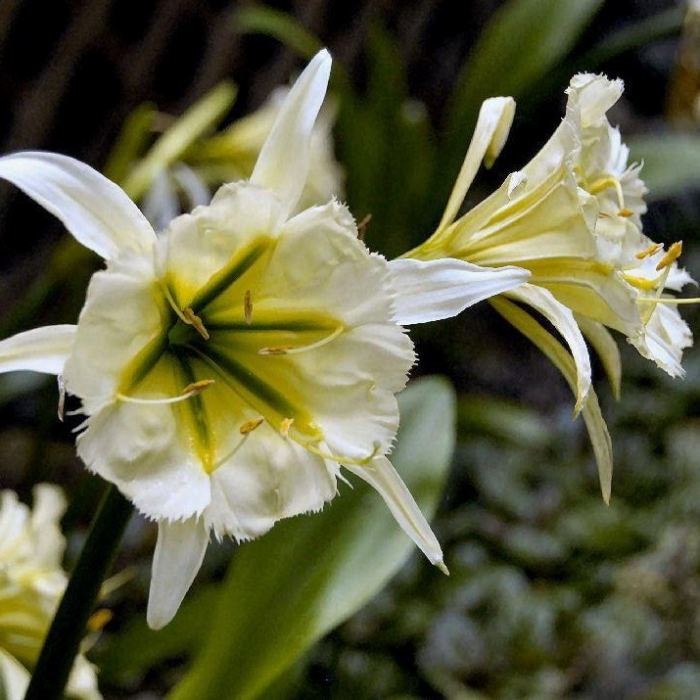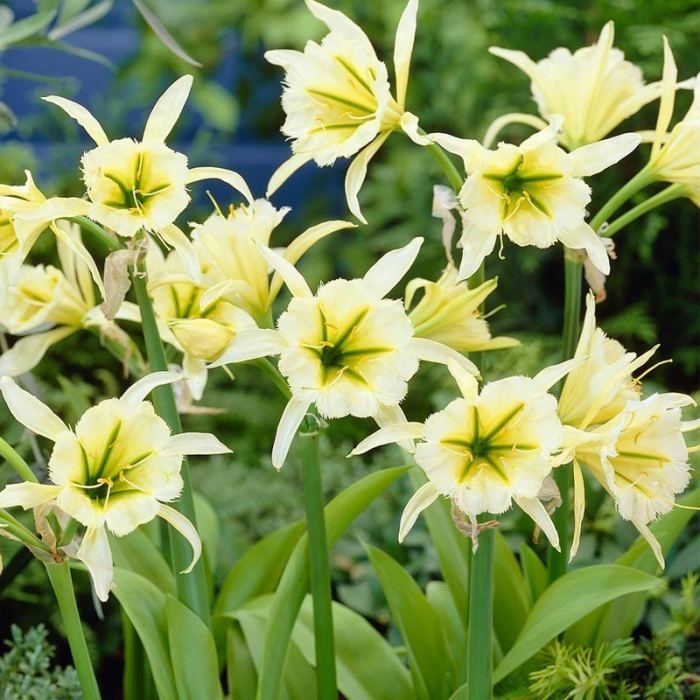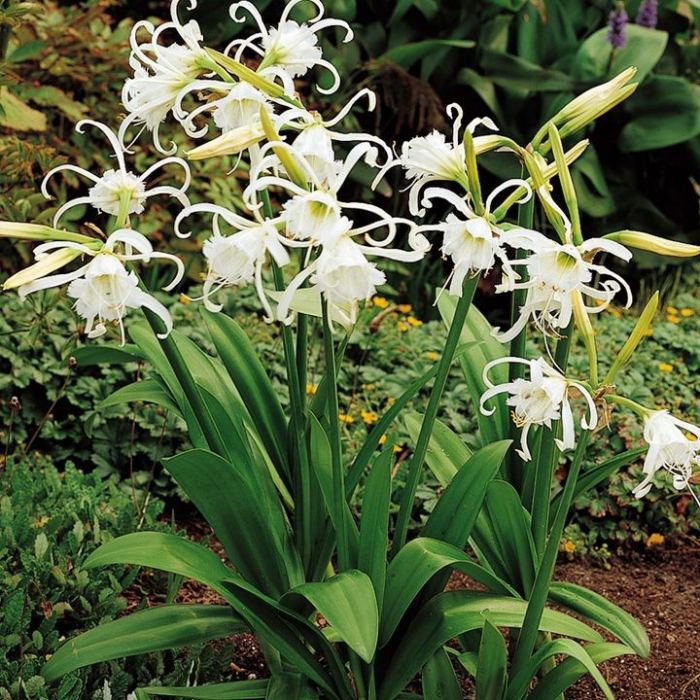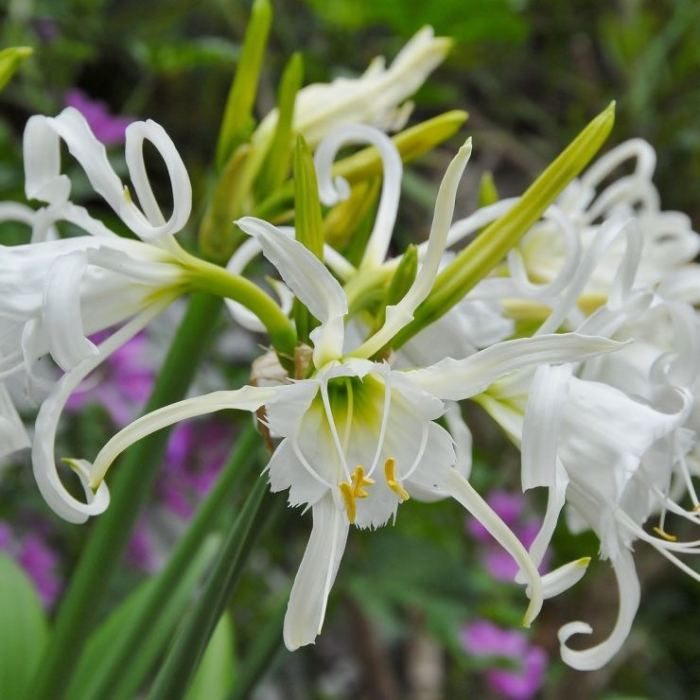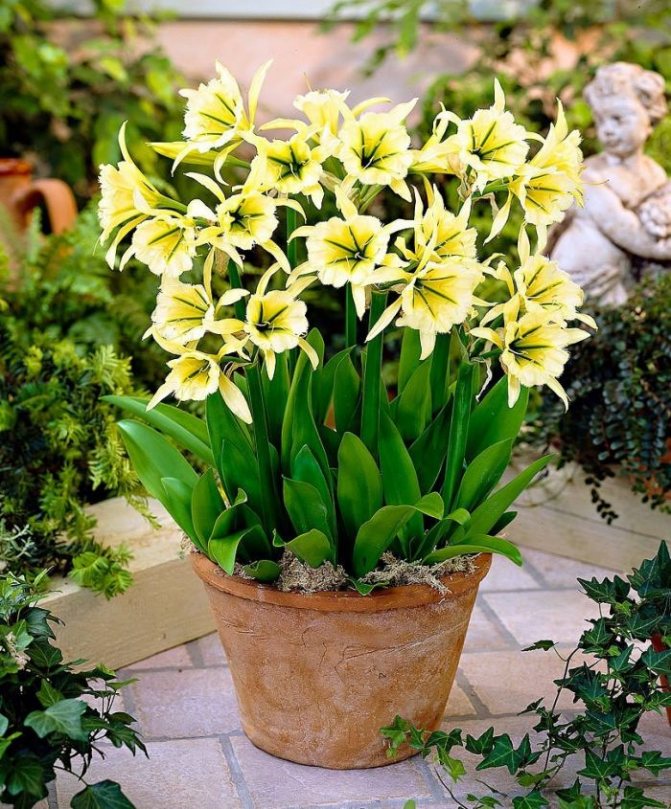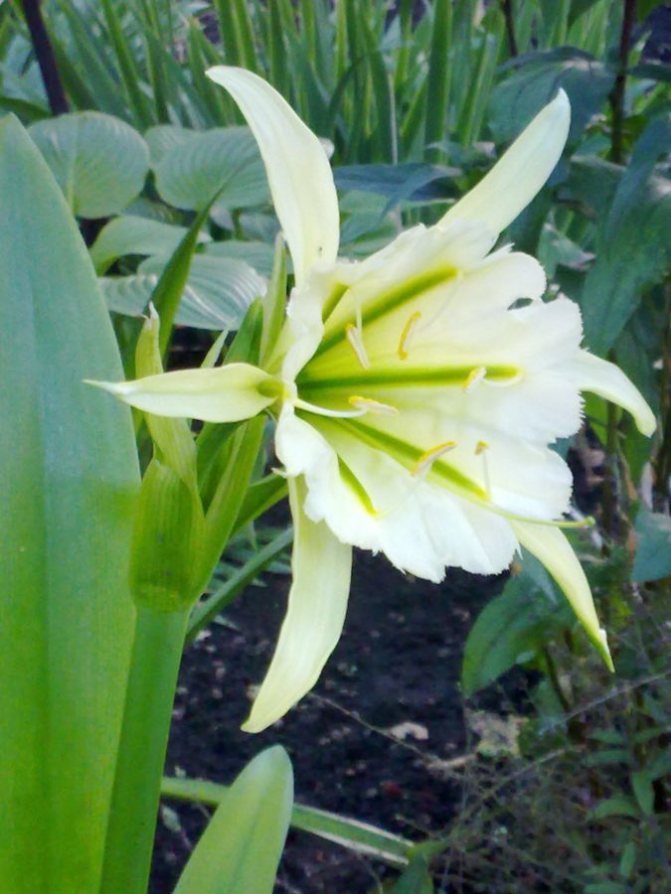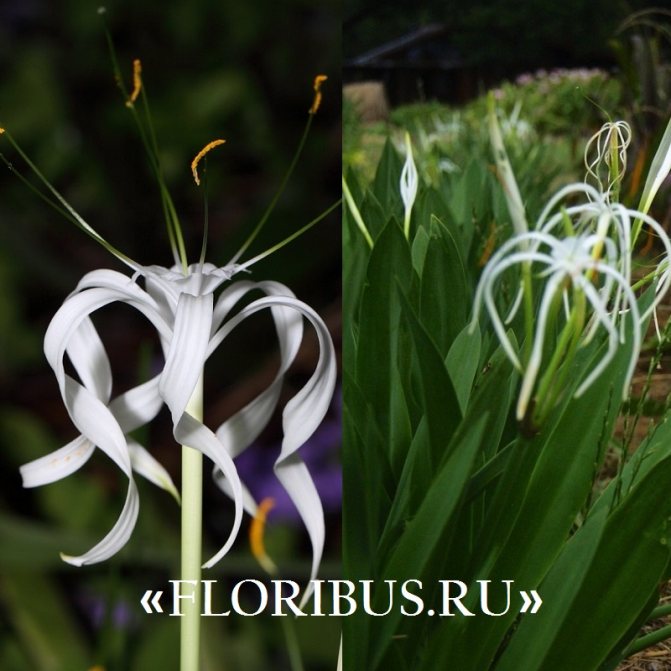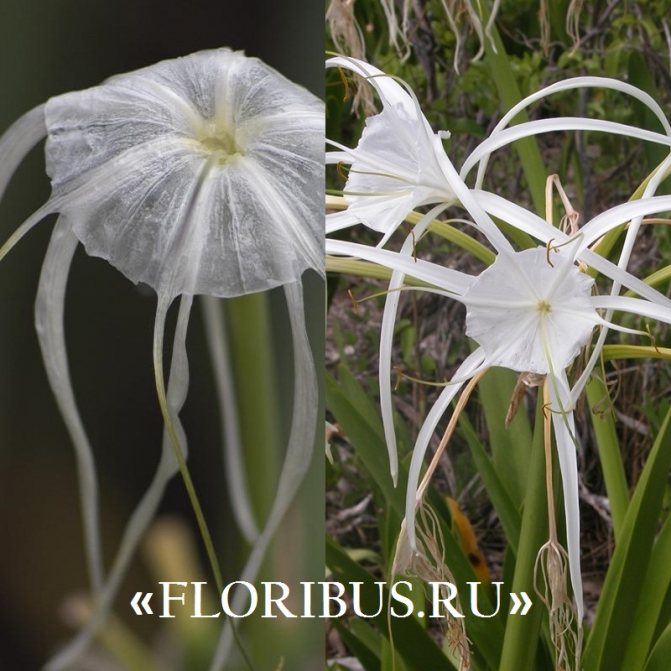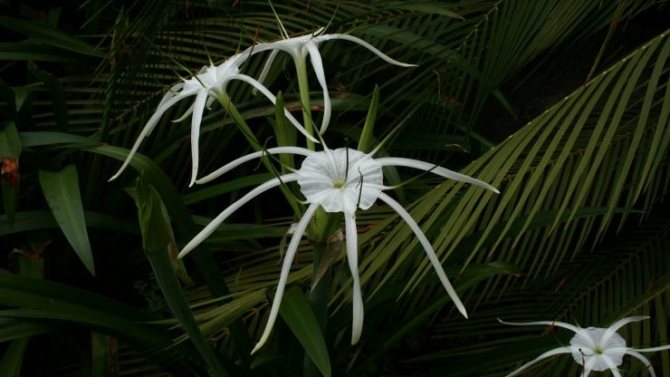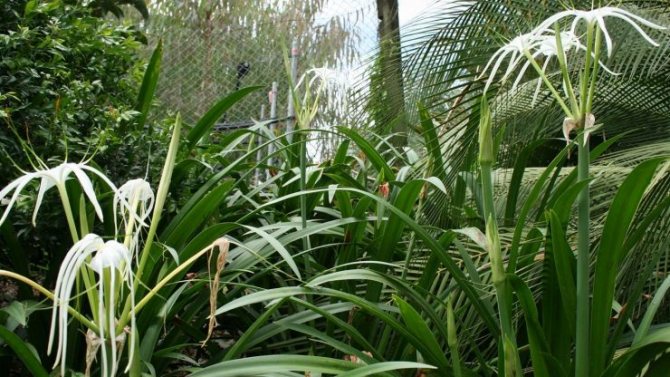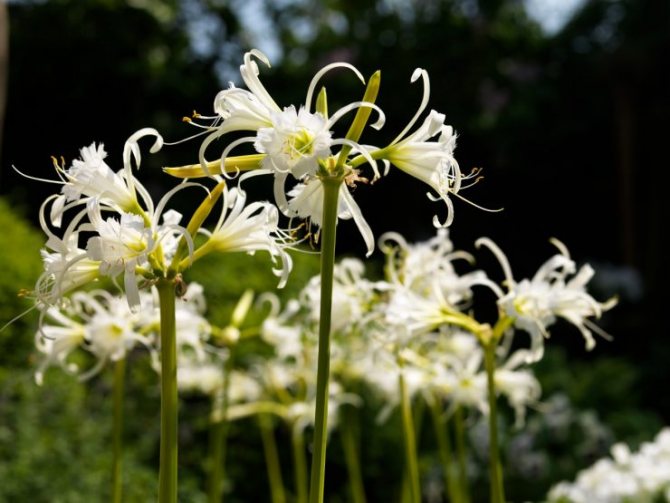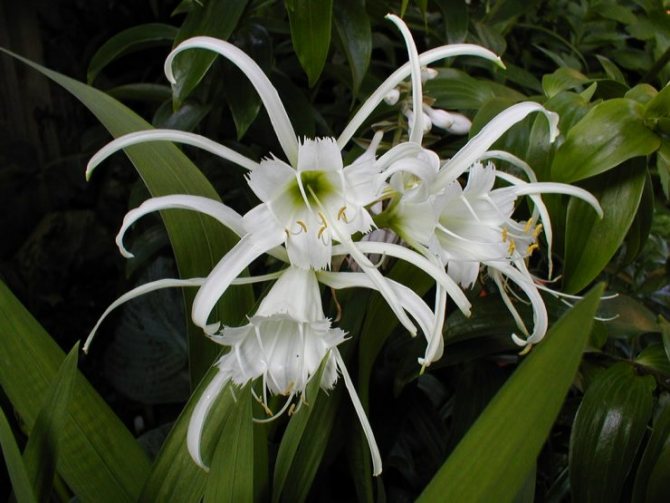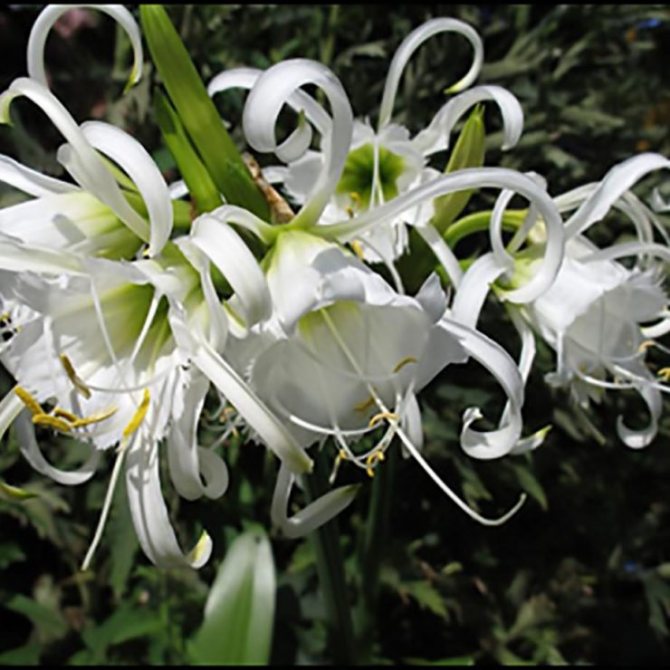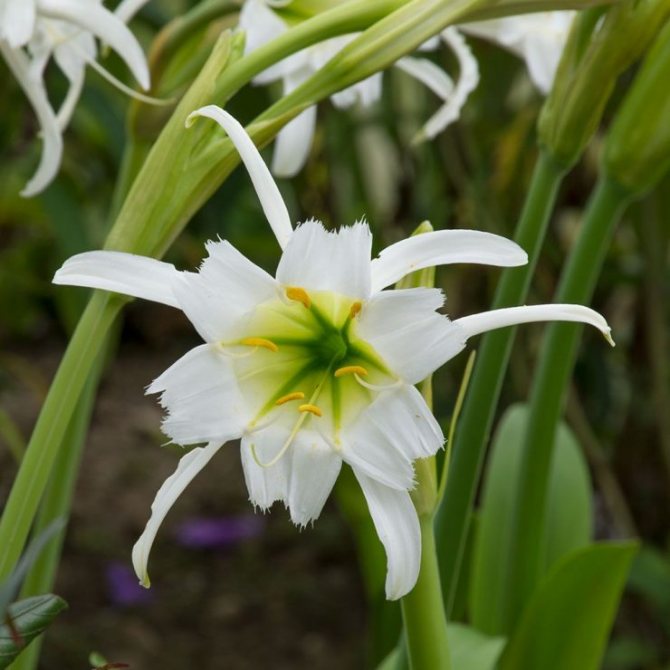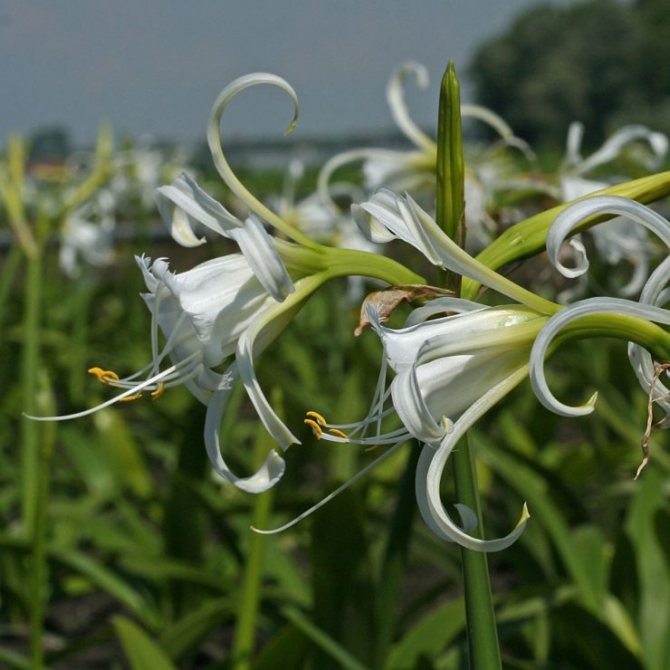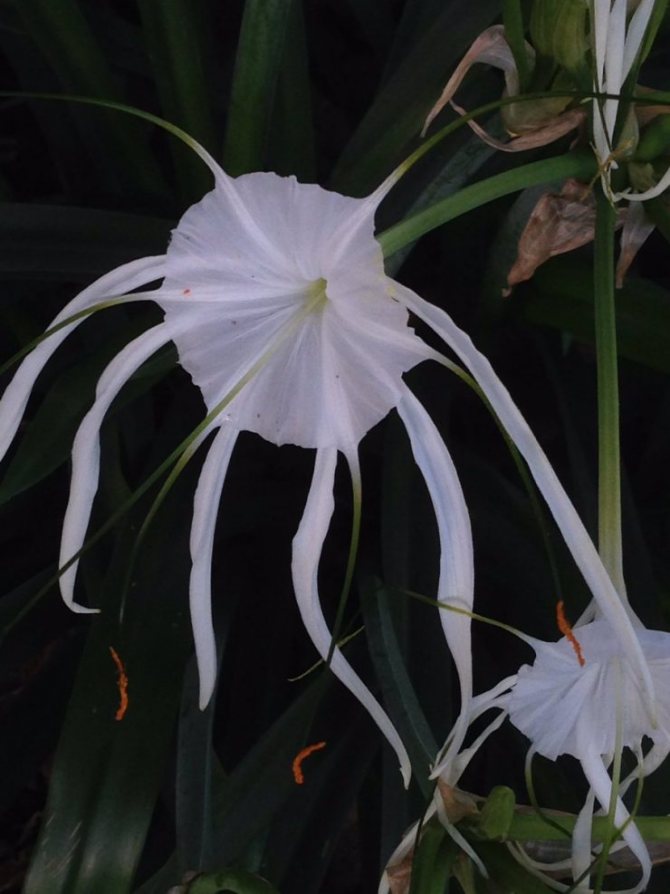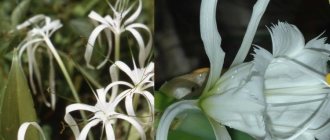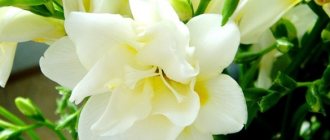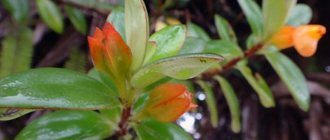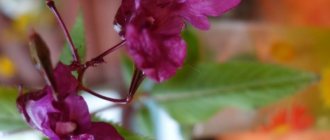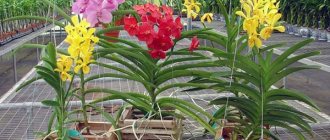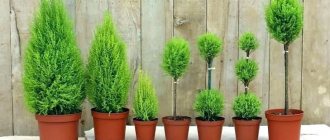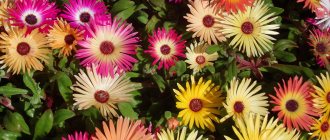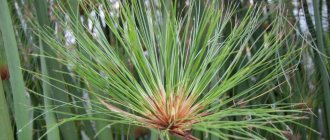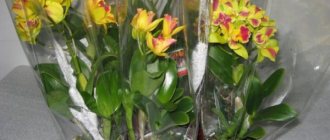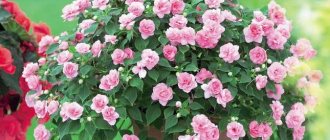Main types
Hymenocallis caribbean (Hymenocallis caribaea)
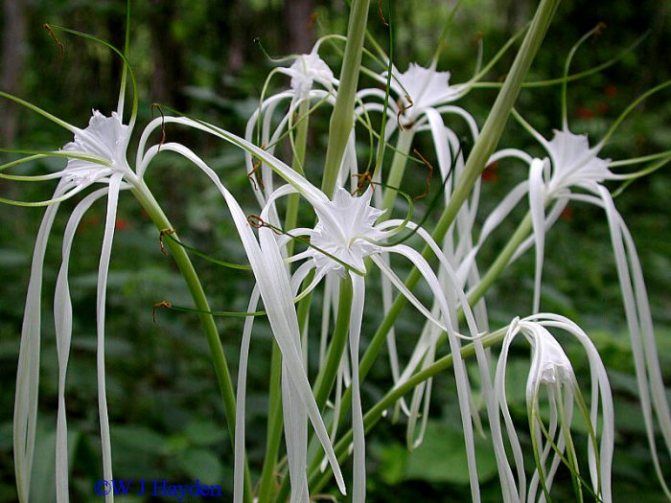
This type is most popular with flower growers. Such an evergreen plant can be found in nature on the coast of the Antilles. He has no rest period. The dark green narrow-lanceolate leaves reach 90 centimeters long and 5-7 centimeters wide. Blooms in winter for 4 months. At the top of the peduncle is an umbrella-shaped inflorescence, which consists of 3-5 large flowers, painted white. Narrow sepals reach 7 centimeters in length.
Hymenocallis early (Hymenocallis festalis)
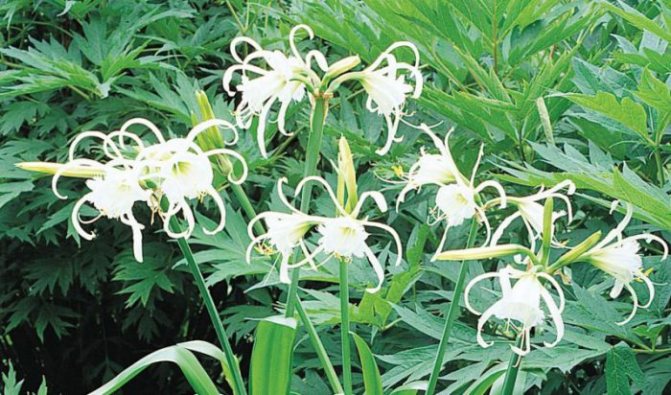

Quite often grown indoors. It occurs naturally in Peru, but it is often grown as a garden plant in subtropical and tropical areas. This species has rather short (from 40 to 60 centimeters) glossy, belt-like leaves, painted in a dark green color. Flowering lasts from mid-spring to mid-summer. Snow-white flowers have a diameter of 10 centimeters. Large, wide-open crown. Curved sepals are rolled into neat rings.
Hymenocallis daffodil (Hymenocallis amancaes)
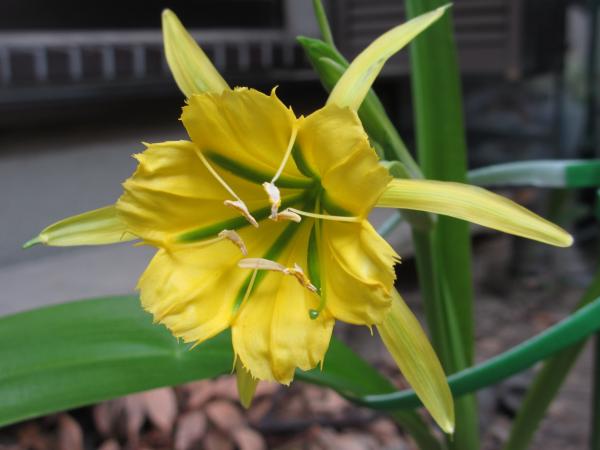

It is an evergreen plant endemic to the coastal mountainous regions of Peru. The dark green leaves are xiphoid. The yellow flowers have a large crown and quite wide. It completely absorbs the stamens, and only anthers remain outside. Sepals are only 1.5–2 times longer than the crown. There are varieties with purple or white flowers. This plant blooms from mid-summer to mid-autumn.
Hymenocallis fine (Hymenocallis speciosa)
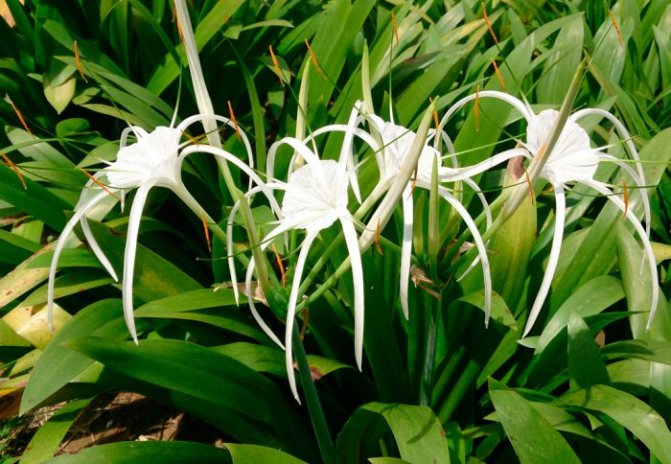

The homeland of this evergreen plant is the Antilles. Long (up to 60 centimeters) leaves have a lanceolate-elliptical shape. On 1/3 part of the peduncle protruding above the leaf rosette, bears an inflorescence in the form of an umbrella, consisting of 5-16 snow-white flowers. Each flower has a diameter of about 15 centimeters, while the arched sepals can be up to 7 centimeters long.
Hymenocallis cordifolia
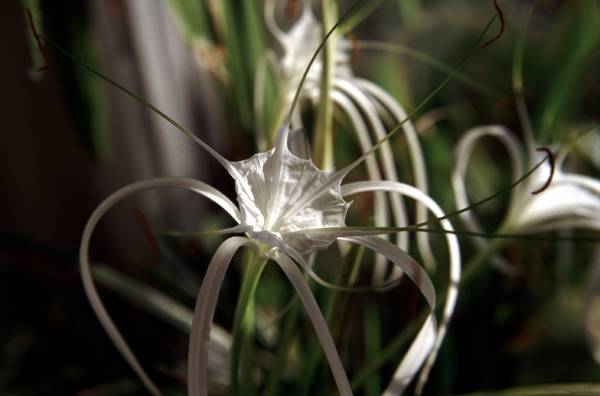

This species is very different from the rest. The long-petiolized leaves of such a plant have an elongated heart-shaped shape. Snow-white flowers with long narrow drooping sepals practically do not have a crown.
Hymenocallis tubiflora
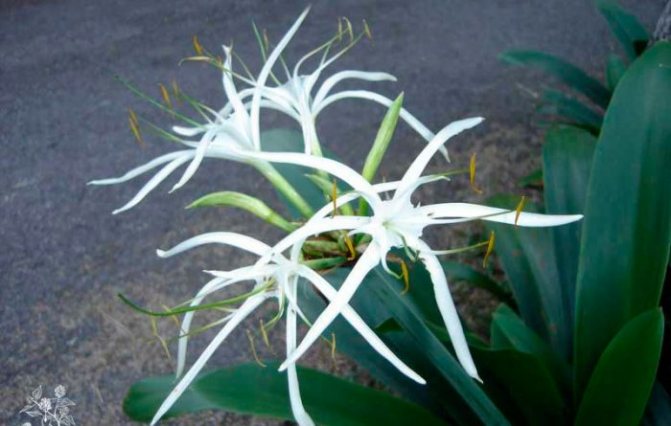

In nature, it can be found in Trinidad and on the northern coast of South America. Its flowers are similar to the hymenokallis cordifolia. However, the petiole leaves are broadly lanceolate.
All indoor-grown species have very few varieties. So, most often the flowers are painted white, less often yellow. There are also differences in the size of the crown and in the shape of the sepals. Variegated forms of such flowers are very popular. They have greenish-yellow or white longitudinal stripes running along the leaf edge.
Hymenokallis species
Fittonia home care, cultivation and reproduction
At home, the most widespread species is the Caribbean Hymenocallis (Hymenocallis caribaea). It is an evergreen plant, native to the coast of the Antilles, which does not have a dormant period.Leaves are narrow-lanceolate, dark green, about 90 cm long and 5-7 cm wide. Long-lasting flowering, up to 4 months, occurs in winter. The peduncle bears an umbellate inflorescence with 3 - 5 large white flowers: their narrow sepals are about 7 cm long.
Another species popular in indoor culture is early Hymenocallis (Hymenocallis festalis). Its natural area of distribution is the region of Peru, but it has long been "domesticated" and cultivated in the gardens of the entire tropical and subtropical zone. It differs in relatively short, 40 - 60 cm, dark green glossy belt-shaped leaves. Flowering time is from mid-spring to mid-summer. The flowers are white, 10 cm in diameter. Sepals are curved in neat rings, the crown is large, wide open.
Hymenocallis daffodil (Hymenocallis amancaes) is an evergreen endemic to the coastal mountainous regions of Peru. The leaves are xiphoid, dark green. The flowers are yellow, the crown is large, wide, almost completely absorbing the stamens and leaving only the anthers free. The sepals are only 1.5 - 2 times as long. Besides yellow flowers, this plant has varieties with white and purple flowers.
Flowering begins in mid-summer and lasts until mid-autumn.
Hymenocallis beautiful (Hymenocallis speciosa), originally from the Antilles, is also an evergreen species. Its leaves are lanceolate-elliptical, up to 60 cm long. The peduncle protrudes about a third above the rosette of leaves and bears an umbellate inflorescence of 5-16 white flowers, about 15 cm in diameter (the length of the arcuate curved sepal is 7 cm).
Quite different from the species described above, Hymenocallis cordifolia (Hymenocallis cordifolia). Its peculiarity is long-petiolate leaves and an elongated heart-shaped leaf plate. The flowers are white, the sepals are narrow, long, drooping, the crown is almost absent.
The species Hymenocallis tubiflora (Hymenocallis tubiflora), which lives on the northern coast of South America and Trinidad, is very similar to the previous one with its flowers. And it also has petiolar leaves, but the leaf plate is broadly lanceolate.
Unfortunately, all cultivated hymenocallis species cannot boast of a variety of varieties. The main color of the flowers is white, occasionally yellow. There are differences in the size of the crown, in its size relative to the calyx, and in the shape of the sepals themselves. And plants with variegation, expressed in white or yellowish-green longitudinal stripes along the edge of the leaf, have also become widespread.
Graceful and magical lily spider hymenokallis
Plumeria home care planting growing from seeds
Hymenocallis is a genus of bulbous plants that occupies a respectable place in the Amaryllidaceae family. This association includes more than fifty varieties of attractive amazing perennials. The homeland of the hymenokallis is the tropical and subtropical part of Latin America, where it grows in valleys near the banks of rivers and lakes, even two kilometers in height does not frighten it.
The hymenokallis flower that came to our places about two hundred years ago, feels ideal both in pot compositions and in open areas, where it creates wonderful species both independently and with its partners. The closest relatives of the hymenokallis are Gemantus, Crinum, Clivia.
The amazing plant hymenokallis lovingly is called by other names: the bride's basket, the spider lily, the Peruvian daffodil, early ismen.
You can endlessly admire the onion exotic with a sweet vanilla aroma of exquisite snow-white flowers of a bizarre shape. Hymenokallis flaunts its belts with similar leaves, the length of which can reach a length of eighty centimeters.They have a fan-shaped divergence from a pear-shaped bulb in dry, shiny scales. Indian onions have similar bulbs. The number of flowers from two to sixteen pieces, which form umbrellas, directly depends on its size. And they are located on a flower arrow, the length of which varies from fifty to eighty centimeters. The extraordinarily fantastic fragrant flowers are especially decorative. Flowering results in oval, fleshy seeds.
The bride's basket looks awesome both in a separate planting and in a company with other plants. It will perfectly decorate the front view of the alpine slides or the central part of the flower bed. Even small bodies of water can be transformed with the appearance of this irresistible exotic. Hymenokallis photo can be viewed in the next section of the article.
Flower and fruit
A flower of an unusual shape, because of which the plant is often called a spider lily. These are tubular buds of white or cream color, enclosed by six long (up to 20 cm) sepals petals; they can be twisted into bizarre shapes or hang freely along the edges of the funnel-shaped corolla. At the base, the petals are green, smoothly turning to the end in white shades. The funnel-shaped corolla reaches a length of 5-6 cm. The buds are very fragrant, collected in basket or umbellate inflorescences of 2-16 pieces. Flowers are located on a long peduncle, which is equal in height to the leaves. It has a flattened cross-section and is most often naked.
After flowering, the fruit is formed - an oblong or oval box with numerous seeds. It has a green tint even at the time of maturation of the planting material. At home, boxes are often used for reproduction.
Hymenokallis home care
Hippeastrum growing and care at home
It is very easy to grow such a plant.
The main thing! Find a bright, good place for your pet and water it with high quality, in a timely manner.
More point by point.
Seat selection and comfortable temperature
Hymenokallis is the most light-loving amaryllis plant. He is not afraid of direct sunlight, within reasonable limits. Ismene will feel comfortable throughout the year on the western, eastern, southern windows. In the warm off-season, he will be happy to enjoy the fresh air in the garden, on the balcony, in the gazebo.
Lack of lighting will negatively affect flowering. Hymenokallis will not bloom.
Acceptable temperature indicators in the summer months are 17-25˚С, the winter temperature difference is 13-18˚С. Deciduous varieties are kept at a temperature of 10-12 ° C, the bulbs must be dry.
Air humidity and watering
Peruvian daffodil is not particularly picky about air humidity. Using a lukewarm shower will help keep the leaves clean.
Hymenokallis care for him will be of high quality with proper watering. It is imperative to monitor the condition of the earthen mixture, which should not be dry. But an excess of water should not be allowed, so as not to rot the roots.
Earthen mixture and its feeding
Lily spider is not prejudiced against the composition of the potting mix, but there are certain requirements. It should be fertile and loose. It can be organized from the following composition: garden soil, peat, manure, sand or perlite. All ingredients must be taken in equal parts. Another option is with three parts of leafy soil, and one part of turf soil and sand. You can buy a ready-made mixture for bulbous plants in the store. It is advisable to correct it with crushed charcoal so that putrefactive processes do not spread.
An actively growing Peruvian daffodil craves quality feeding. Liquid fertilizers for bulbous or flowering houseplants are suitable.
Attention! Don't overdo fertilizers with lots of nitrogen.They have a positive effect on the growth of leaves and bulbs, but reduce the length of the flowering period of the plant.
Transfer
For a changeover, a transplant with a period of four years would be acceptable. Choose a beautiful flowerpot for your pet with a hole three centimeters freer than the previous one. A good drainage must be laid on the bottom.
Remember! Blooms and changes more abundantly in a slightly cramped pot.
How to propagate a spider lily?
Reproduction is carried out using seeds or daughter bulbs, which are four years old. They need to be disconnected from the main bulb and planted in a separate flowerpot for permanent residence.
The seeds are sown in a mixture of peat and sand. Long-awaited seedlings can be seen a few months after sowing.
Diseases and pests of hymenocallis
Uninvited guests rarely visit this beautiful and spectacular indoor flower. But, sometimes, if the rules of cultivation described above are not followed, change can be a breeding ground for spider mites, aphids, or thrips. If these insects are found, we immediately treat the plant using insecticides. Actellik or fitoverm will do.
Difficult moments of growing
- Why doesn't spider lily bloom? This misunderstanding can be corrected by fulfilling the wishes of the plant. It needs to be fed, to improve lighting, to check the correctness of watering. During hibernation, the temperature regime was not maintained.
- Sluggish leaves - excessive or insufficient moisture in the earthen coma.
- The leaves are covered with oblong red spots - the plant has received a burn.
- The bulb rots - stagnation of water in the pot is possible due to poor drainage. Apply a weak solution of potassium permanganate for prophylaxis.
We take care of Gimeokallis in good faith, plus a little love and comfort, and in return we get an abundant whimsical flowering of our pet. Accuracy in this process will not hurt, because the flower is poisonous.
You can admire the bride's basket without stopping, and other indoor flowers, photos and names can be viewed by opening the catalog of indoor plants on the website.
Go for it! Happy viewing!
Description of hymenokallis and his photo
Hymenokallis flowers have a large stem with fragrant snow-white flowers with tall, spider-like, pale yellow calyx-shaped petals and large, quivering stamens. Flowers can appear both in late summer and early autumn. One inflorescence can have from six to eight shiny white flowers up to 20 centimeters in length. The staminal cup is about six centimeters in diameter. The flowering stem reaches a height of 30 to 60 centimeters. The foliage, which outwardly resembles a sword of the knightly era, has a gray-green tint and grows in late spring. It begins to fade towards the end of summer, if the weather without rains persists for a long time. Look at the photo of hymenokallis flowers:
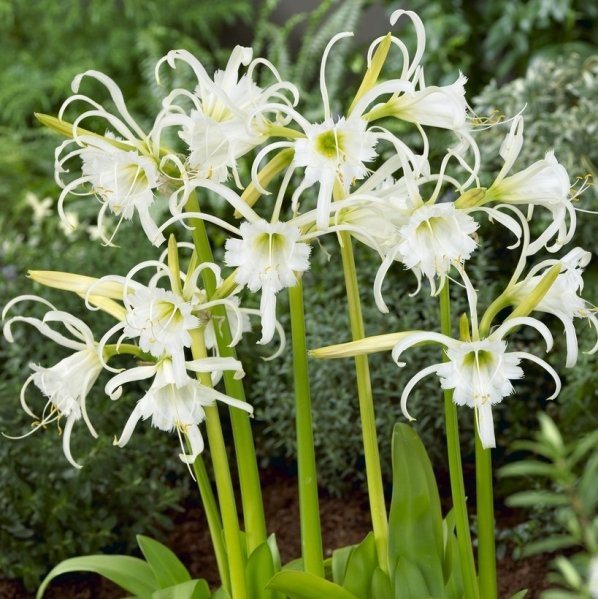

Hymenocallis seeds are fleshy and can be very unusual and may vary slightly in size per pod. When the seeds are ripe, you just need to drop them into the soil in the peas along with the parent plant. The ground must necessarily remain moist, and then, with proper care, in three to four months you will have the first shoots. Some growers choose to sow mixed seeds. In early spring, subspecies such as hymenokallis lyriosme, hymenokallis koronaria and hymenokallis crassifolia germinate within a month or so. And later species will not be able to germinate until the next spring. This is a general description of Hymenokallis as a horticultural crop. Now let's move on to the rules of caring for him.
For every taste and color
Today in the world there are more than 50 species of exotic plants, but gardeners prefer only a few of them.
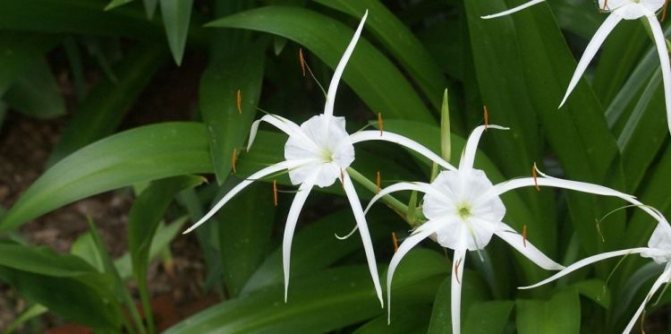

Coastal is an unpretentious and beautiful variety, with long (up to 80 cm) green leaves and fragrant flowers that look like large white spiders.The height of the plant can vary from 30 to 40 cm, while it does not need diligent care.
Read: Aichrizon: description, types of plants, care and rules for growing a flower. 135 photos and videos of the main varieties of aichrizon
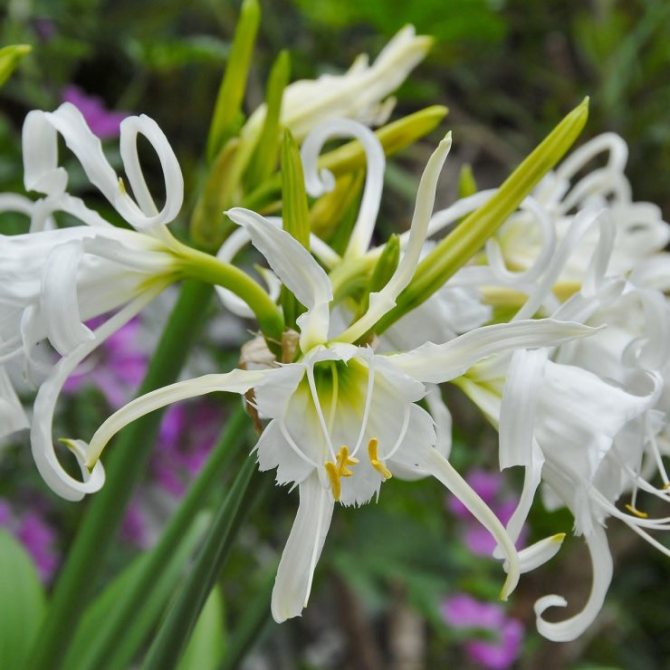

Caribbean is a thermophilic perennial that prefers indoor keeping. White flowers of hymenokallis with bright yellow stamens look very impressive, but so that the plant delights you with beautiful shoots for as long as possible, put a pot with it on a sunny windowsill.
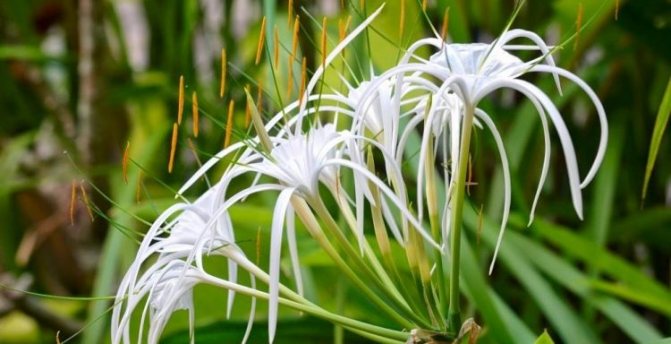

Pleasant (wonderful) - a guest from the subtropics, whose distinctive feature is large, umbrella-shaped flowers, exuding a delicate aroma reminiscent of the smell of lilies. Usually on a powerful peduncle from 6 to 12 such "decorations" are formed.
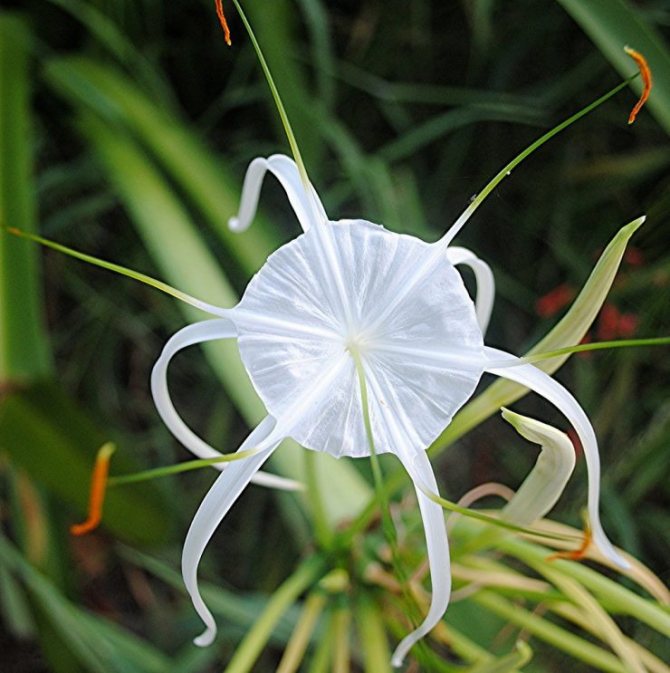

Broadleaf is an ornamental herbaceous crop, whose name speaks for itself. Its distinctive feature is large xiphoid leaves with a clear vein in the center.
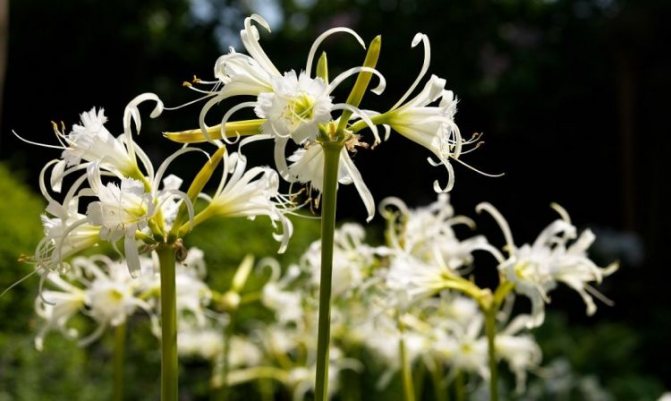

General information about the culture of hymenokallis
This plant belongs to the amaryllis family, known to avid flower growers, which gave the world of people many decorative species of flora. The region of the original and currently key distribution of wild representatives of the genus Hymenokallis covers several large areas of our planet: the Antilles, South and North America. They invariably grow in tropical and subtropical regions, and specifically on river and sea coasts, in valleys and mountains.
Hymenokallis is amazing. From an oblong large bulb of a light brown shade, grooved soft sheets develop with pointed ends, a belt-like shape and an impressive length of more than half a meter. In late autumn or December, the plant acquires high peduncles, crowned with umbellate inflorescences of 7-15 buds. The latter, opening, turn into excellent flowers: beautiful, delicate, with long curling petals and a crown of stamens fused from below. The reproductive organs of the hymenocallis are yellow or white. They are fragrant and the aroma is reminiscent of that of vanilla.
Hymenokallis means "hymn of beauty"
... Apparently, those who so called the exotic were in complete admiration for his perfect appearance. Previously, the flower was known under a different name: pancratium. The Dutch call him “change”. In general, hymenokallis is one of some indoor crops, in the arsenal of which there are at least several different names invented by the people. Most popular: Peruvian daffodil, spider lily, bride's basket, membrane flower, harmless pipes.
Photo: hymenokallis
Common names
Hymenokallis is also called the spider lily and the Peruvian lily. In addition to these, there are many other names.
Some botanists with extensive experience provide data on such a name as Ismene, which is synonymous with Hymenokallis. But most breeders insist that these plants have nothing in common and belong to a different genus. But it should be noted that it was hymenocallis that was used for excretion and change. The presence of a false stem in izmen clearly distinguishes it from hymenokallis. Its formation occurs when foliage dies off. In addition, they are distinguished by flowering shoots. Ismene has flowers in a horizontal position, while the spectacular flowers of the second are in an upright position. The crown of the hymenokallis is of the same color, while in the case of change it has a longitudinal evil stripe. Some signs of narcissus hymenocallis are similar to change, so they can be talked about as plants of the same genus. Ismene is also called daffodil, it has horizontal bent pedicels, and the place where petals grow together with stamens of a dark green color.
There is often confusion between pancratium and hymenocallius. This is due to their flower similarity. In fact, they belong to a different genus.You can tell the difference by looking at the foliage. In the first, they are tough, narrow, in a small amount of gray-blue color, on which there is a bluish tint, and are similar to succulent species. The second has a lot of foliage of a rich green color and with a glossy surface.
Bulbous plant hymenokallis
For me, bulbous are such a colossal source of vital energy, like, perhaps, no other plant. I never cease to admire their strength, their aspirations by all means to show the world their magnificent flowers. See how energetically the "morning" of the new season begins in bulbous plants. They do not look like some lazy and slothful people who bask in bed for a long time and still do not want to wake up after a sweet night's sleep. Bulbous ones "get up" immediately, as soon as their internal alarm clock rings. In a few days, from an unremarkable bulb covered with dry scales, a delicate green peduncle soars up. For crocuses, lilies and gicints, this will be a tight ear of rolled leaves, hiding somewhere deep within itself the cherished bud. A week passes, then another, and a luxurious flower blooms at the top of the peduncle. It would seem - well, where does such a relatively small onion have so much strength? This is one of the mysteries of nature, which gives me personally that very charge of cheerfulness and desire not only to exist in this world, but to live an interesting, amazing life, in which there is a place not only for everyday life, but also for wonderful holidays. So if you are suffering from depression, bouts of melancholy or bad mood, if you are tired of life and your heart is gradually filled with apathy and indifference - take a moment and go to the nearest flower shop. On its counters, a bulb of either a luxurious hippeastrum, or a fragrant hyacinth, or a whole family of cheerful crocuses will most likely languish in anticipation of meeting you. Believe me, no plant will show you so brightly and juicy all the power of nature, all its endless beauty and energy, like bulbous! And if you want not only to make friends with representatives of bulbous plants, but also to get acquainted with a large original from among them, then invite hymenokallis to your place. This luxurious representative of the amaryllis family cannot be "reproached" for modesty and nondescript. Its luxurious, simply amazingly shaped, fragrant flowers are crowned with a peduncle reaching 60-70 cm in height. In shape, the flowers of the hymenokallis vaguely resemble a daffodil and represent a large elongated funnel, from the base of which long and narrow tepals grow, and inside a whole flock of graceful slender stamens, looking out from the bosom of the flower for about half of its entire length. The color palette of hymenocallis flowers is rather narrow and ranges from white to pale lemon. Moreover, the newly blossoming flower is snow-white, and over time, as the flower withers, its color gradually changes to pale yellow (a similar color metamorphosis is observed in gardenia flowers, which bloom and amaze the eye with their airy snow-white, but after a couple of days they turn into soft lemon flowers). Hymenokallis is interesting because even in the middle lane it can be cultivated not only as an indoor plant, but also as a garden plant. I have no experience of growing hymenocallis in the garden, so I can only share the information that I have gleaned on this issue from books. Usually, early hymenocallis (Hymenocallis festalis) or early change (Ismene festalis) are bred in the garden. To do this, choose a well-lit area of land, protected from direct sunlight. The bulbs are planted at the end of May to a depth of 12 cm. Flowering occurs in August. With the onset of cold weather in October-November, the bulbs are either dug up and stored in a cool and dark room, or the plantings are mulched with a thick layer of peat or fallen leaves.It is not recommended to transplant hymenokallis more often than once every 2-3 years, since its more frequent implementation will negatively affect flowering. During transplantation, the formed daughter bulbs are cut off, which are immediately planted in separate pots.
Hymenokallis landing calendar
| first onion | second onion | |
| purchase | ||
planting hymenokallis
| ||
| a sprout appeared | 01-03 | 25-02 |
the sprout grows and gradually turns into a leaf
| 10-03 | 10-03 |
| My sprouts hymenocallis grow by leaps and bounds and have already grown up to 1 meter in length! But the peduncles are not yet visible. I don’t know how long this will last, but as long as I regularly water and feed them, we will see further :)) | 26-03 | 20-04 |
| a peduncle appeared | ||
| beginning of flowering | ||
| end of flowering | ||
| wilting of the peduncle | ||
| wilting leaves | ||
| cessation of watering |
Another necessary addition. As you can see from my planting calendar, I purchased two hymenocallis bulbs from different suppliers at almost the same time. The first bulb of hymenokallis was brought from Holland, the second is the product of our domestic florists. The condition of the first bulb did not give me any worries - the bulb was strong, without any signs of disease, in a dormant state. The second bulb was in much worse condition. I had to remove almost all the upper scales from it, since under them both black rot and traces of red burns were hidden. After thorough mechanical elimination of the foci of the disease (cutting out the affected areas with a sharp, clean knife), I carried out additional treatment with the preparation "Maxim", which protects bulbous plants from almost all types of fungal and infectious diseases. Considering all of the above, I would like to warn you against buying low-quality seed. Even taking into account the relative cheapness of hymenokallis bulbs (Dutch - at 40 rubles apiece, domestic - at 23 rubles), first of all, we need to think about the fact that we are not buying just one or two more bulbs, but we are inviting another friend to our house. And his health depends not only on how luxuriantly and for a long time he will bloom, but also whether he will “share” his illness with the rest of your green family. Therefore, always study the bulbs you buy very carefully. Now they are almost all the time sold packed in plastic bags filled with shavings or dry peat. In such conditions, it is almost impossible to thoroughly examine the bulb, but you still try to at least see if there are scarlet or crimson spots on the bulb, if there are areas that seem to be sprinkled with black powder - if you see at least one of these signs, give up without hesitation purchases. Only if the bulb you saw is the object of your old dream and long search, as well as if you are ready to carry out thorough processing - only then you can decide to buy. However, immediately buy a bag of "Maxim" - this tool has never let me down in the fight against "newly bought" misfortunes. I sincerely wish you good luck and mutual affection in communicating with the hymenokallis and really hope that you can send me at least one small photo of your pet - I will be very, very looking forward! For my part, I promise to keep you informed of all the changes taking place on my "bulbous" windowsill and to acquaint you with all its new inhabitants, as well as with new flowers and shoots that appear in its old inhabitants.
What should be done if the plant is sick?
Below is a list of the most common problems that can be encountered when growing hymenokallis:
- Pale leaves and withered flowers - the volume of water for the plant should be increased;
- The formation of wormholes on the flowers - cause them to be excessively damp and cold;
- If characteristic yellow inflammations appear on the leaves, then it is worth moving the plant to a darker place;
- Also, yellowness, together with wilting of the leaves, suggests that the plant has an excess of moisture - it is necessary to reduce the volume of water.
Diseases most often appear due to violation of watering rules. If you find symptoms of a disease in a plant, first of all, it is necessary to cut off diseased leaves - sprinkle the cuts with ordinary charcoal.
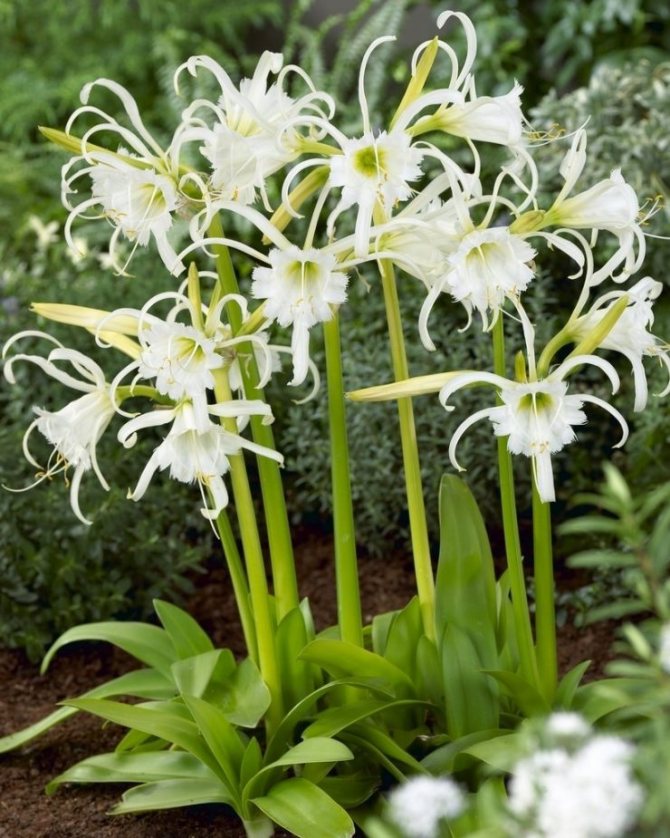

It is also necessary to reduce watering of the plant and ventilate the room well.
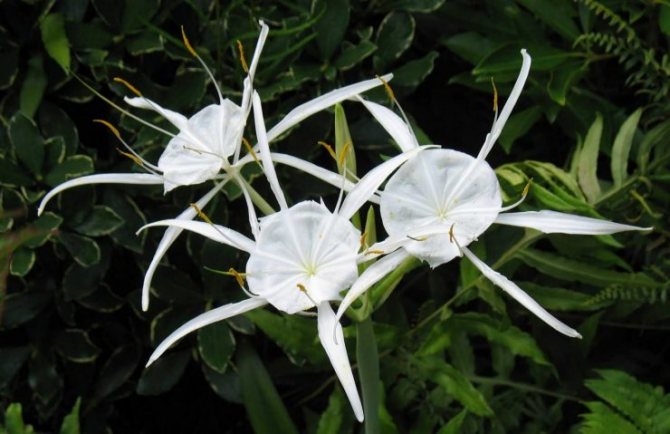

From watering to breeding
Hymenokallis requires systematic care. The home flower prefers bright light, is able to endure the midday sun for some time. But it is best for him to choose the east and west sides. The flower will have little light on the north window.
Hymenokallis in nature
After the plant has faded, it can be displayed in the garden or on the balcony. At the beginning of autumn, the pot with this exotic creature should be brought back. In winter, you can provide additional lighting with fluorescent lamps.
During the flowering period, the plant requires a temperature regime close to 18-22 degrees, and after that it can be reduced to 16-18. A certain air humidity is not required. You can pamper yourself with spraying, although this is not considered a mandatory procedure. But do not forget about the main condition here: when spraying an already flowering plant, water should not fall on the petals.
The soil for the hymenokallis should be sufficiently nutritious, since the indoor flower develops very intensively. Garden soil with the addition of humus and sand or dry mullein is ideal as a substrate. It is better to take a pot for planting wide and spacious.
Good drainage will have to be created at the bottom of the container. The bulb is planted so that 1/3 of it protrudes above the ground. It should be fed with flower fertilizers up to twice a week during the growth period, monthly - during the dormant period.
At the time of vegetation and active growth, abundant watering is required. At the same time, the water should be soft and settled. This inhabitant is quite hygrophilous, so overdrying should not be allowed, especially in summer. During the rest period, watering does not stop, but its frequency simply decreases.
The transplant is carried out only when necessary. Young plants are transplanted every two years, adults - once every four years. The transplant can be carried out only during the rest period. Before starting work, you must carefully examine the bulbs. It is better to cut off the affected areas and treat with crushed charcoal.
The domestic hymenokallis flower propagates with the help of daughter bulbs.
How to grow hymenokallis outdoors?
Spider flower
This exotic creature can be grown outdoors. But one condition should not be forgotten: the bulbs are necessarily dug up every year and stored in the room until spring.
In order for the flower to grow faster, at the beginning of February, the onions must begin to germinate at a temperature of 10-15 degrees. In early May, they can be planted in the ground. Well-lit areas are suitable for growing. The soil should be loose and light. Drought and waterlogging should not be allowed. Fertilizers are recommended to be applied four times during the entire growing season. As a top dressing, you can use a mixture that includes phosphorus and nitrogen.
Hymenokallis rarely gets sick and is attacked by pests. But problems can still arise. If the hymenokallis does not bloom, then it lacks light or nutrition. There are other factors that affect the condition of the plant:
- sunburns appear with an excess of direct rays;
- waterlogged soil can lead to leaf lethargy;
- if the buds begin to fall off, then it is necessary to increase the frequency of watering.
- gray rot can occur when there is an excess of moisture in the pot.
If you can properly care for your green pet, then there will be no problems. The plant will delight you with its beauty and abundant flowering.
Diseases and pests
The biggest problem can be the gray rot of the bulb. This is the result of improper watering, or rather overflow, stagnant water, especially at cold temperatures. When transplanting a plant, the bulb must be carefully examined for damage. If small areas of decay are found, then they can be removed and sprinkled with coal. In the case of an extensive outbreak, the plant cannot be saved.
Anthracnose also occurs with chronic overflow and high temperature. You can understand this by the black dots on the leaves and brown streaks at the ends. Treatment consists in reducing watering, removing diseased areas, and ventilating the room.
Red dots on the leaves indicate staganospore. First, the bulb is affected, and then the leaves. With a mild degree of infection, foundationol will help (2 g per liter of water), and in a difficult situation, treatment with a mixture is required:
- chalk - 100 g;
- vitriol - 5 g;
- adhesive - 10 g.
Pests:
- spider mite;
- thrips;
- aphid.
Treatment with insecticides is similar, although you can try alternative methods, such as applying a layer of tobacco dust. If the infection with thrips is strong, then the soil will have to be completely changed.
Hymenokallis signals about care errors:
- pale leaves, flowers withered - lack of water;
- wormholes on the petals - a higher temperature is needed;
- yellow specks on the leaves - direct light, excess;
- leaves turn yellow and lose elasticity - overflow;
- no flowering - wrong dormancy (flower bud could not form) or low temperature.
Soil for hymenokallis
This is due to the fact that for good flowering, it is necessary for the plant to grow, and not to develop its root system. Caring for young plants involves transplanting them every two years, and if the flower is already an adult, then it is transplanted every 3-4 years. Since hymenokallis reproduces by a bulb, then before planting it must be thoroughly examined. When observing the slightest damage, they are cut off, and the cut spots are sprinkled with coal.
Drainage must be placed on the bottom of the dishes. The soil in the pot for it should be rich in minerals, since in good conditions the flower grows intensively and consumes many nutrients. Therefore, for planting it, they are mixed in equal quantities: turf, humus and leafy soil, peat and sand are also added there.

